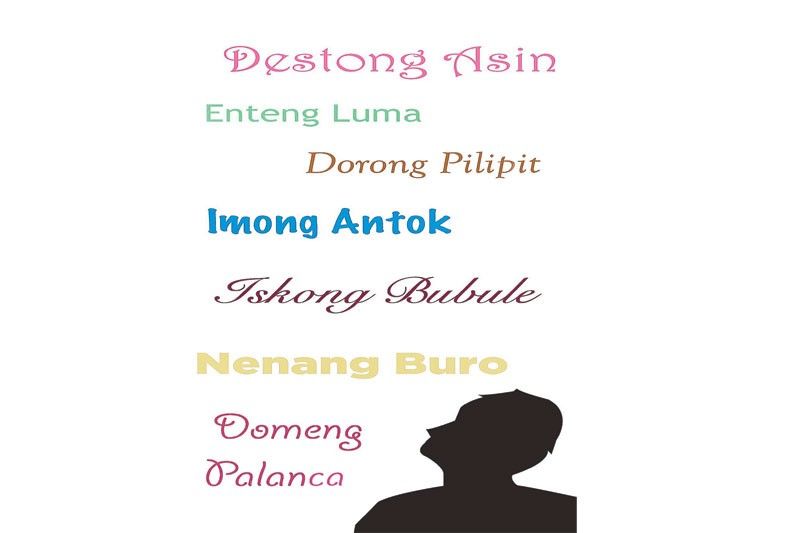Dorong Pilipit, Anong Bualaw, Destong Asin & Enteng Luma — what’s in a name?


In Gulod, in the past, my brothers and I were barely known by our names to the elderly in the neighborhood but by the moniker attached to our grandfather’s name. Lolo Doro stuttered so the barrio folk thought he had a twisted tongue. He was tagged for life as Dorong Pilipit and us, his grandkids, as apo ni Dorong Pilipit.
Pilipit, of sort, became the common name of our family. Those who lived outside our barrio and had not been to our house would easily find us by telling the jeepney driver: “Ibaba niyo ho ako kina Dorong Pilipit.” And with 100-percent accuracy, they would find us.
The moniker attached to a family’s name in Gulod served as a marker that was as accurate as today’s Google Maps. It was the Waze of long time ago, minus the detours or rerouting.
If we needed to buy our school supplies, we went to the sari-sari store of Destong Asin. The owner of the store earned the tag because his father-in-law was known to be so frugal that he could subsist by just having salt in his rice. Desto, according to his son engineer Manolito Barundia, was said to be close to his father-in-law that the sobriquet was passed on to him.
To settle disputes in the barrio, people went to a peacemaker named Enteng Luma. Everybody knew him as Enteng Luma but not everyone was privy as to why he was called such. His daughter Lucy — called Lucing Luma — said her father always found use in objects that were already luma (old). While others discarded their old and dilapidated appliances, Enteng Luma would wield his magic and turn them into functioning objects again.
A funny story is told by businessman Romy Gimutao, my kumpare in the barrio, about his father, known as Anong Bualaw. Bualaw is the popular name of his clan. Bualaw is the other term for binatog, a dish of boiled corn garnished with grated coconut. One time, while Anong’s father, Berto, was courting the beautiful Loleng, he brought her and her friends to the lake on a motorized outrigger. They had a picnic of bualaw while promenading the lake on a banca. Berto had one serving too many of the bualaw and as his fate would have it, he experienced a “stomach revolution.” Still far away from the docking area, Berto was forced to unload in the middle of the lake. It was an embarrassing experience for a lad like him but that situation endeared him to Loleng. From then on, he became known as Bualaw, and his well-to-do son Anong became Anong Bualaw. And everybody in their family had been known as a “bualaw.”
A quirky sobriquet is more popular than the person’s last name in the barrio perhaps because it is human nature to always remember the stories behind the tags. Many clans in the barrio can be very big that a lump-sum name is needed to identify one family.
Anak ni Lociong Buririt refers to the son or daughter of a stout farmer who was so small people compared him to a buririt, a small rat. When he got drunk, he made friendly banter with the people in Gulod — speaking in straight, impeccable English. (I looked forward to meeting him on the streets of our barrio because I could practice my language skills with him.)
My aunt Fortunata’s husband was called Enteng Adobo because his family was known to only know adobo as their food for breakfast, lunch and dinner — every day.
And to this day, if we want to order the yummiest pancit in the barrio, we go to Aling Naty, who lives in a compound called Patisan, the moniker of the Lazanas family. The Lazanas forebears were called patis because, according to the research of my friend, Jhobes Lazanas Estrella, a rising fashion designer, his family’s great-grandfather made fish sauce as the family business in the barrio.
A man named Primo Hermano, married to my father’s half-sister, was not known by his real name but by the term Imong Antok. Imo, a jeepney driver with fair skin, easily fell asleep wherever he was. One time, his passengers scampered to get off his jeep when Imo fell asleep while driving. No one was hurt. When he woke up, he wondered where his passengers were. He stopped driving from then on. To this day, all his children and grandchildren also have to carry that moniker. And how happy they are to be called “Antok.”
Another man is called Sonny Kalabaw because of his stout built. He was said to be so strong in his prime that his strength was comparable to that of a water buffalo’s power. He has remained to be a living “marker” in the barrio, never mind if people forget that his last name is Aldueza.
When a family is called “Tabla” that means once upon a time someone from that clan sold lumber. There’s also a compound called “Sampalukan” for in the midst of the clan’s houses is a giant, mighty sampaloc tree. Another compound is called “Tambok.” In the neighboring barrio of Marinig, the Tenorio clan is known as Negruhan (because in that compound the people are dark-skinned) while the Librero family is collectively known as Paminta.
Because there are so many women named Rose and Rosie in the barrio, a businesswoman came to be known as Rosing Paguio. Another businesswoman in the barrio is called Aning Galo, which is a combination of her and her husband’s names. The names Rosing Paguio and Aning Galo have been verbal markers in Gulod for as long as I can remember. Did I mention that they are fine women, too?
Here are other monikers that served as landmarks in my childhood: Nenang Buro, Pedrong Talong, Leving Baluktot, Ponceng Labo, Idong Mura, Domeng Binalot, Domeng Palanca (even if his last name is Gimutao), Bertong Kalawang, Teding Bukayo, Poleng Tamaraw, Litong Hikaw, Enteng Bayong, Galong Balembang, Iskong Bubule, Felipeng Bermot, Idiong Balagbag, Menteng Bungkong, Carling Palaka, Bertong Ibayo, Joey Kwago, Toning Kupeng and Gering Daga.
What’s in a name? A lot. In a name is a quirky way of knowing the people in my neighborhood. More than that, it is a way of understanding a community that thrives in celebrating a family’s own history.
And I will always be proud to be called “apo ni Dorong Pilipit.”
(For your new beginnings, e-mail me at bumbaki@yahoo.com. I’m also on Twitter @bum_tenorio and Instagram @bumtenorio. Have a blessed Sunday!)















